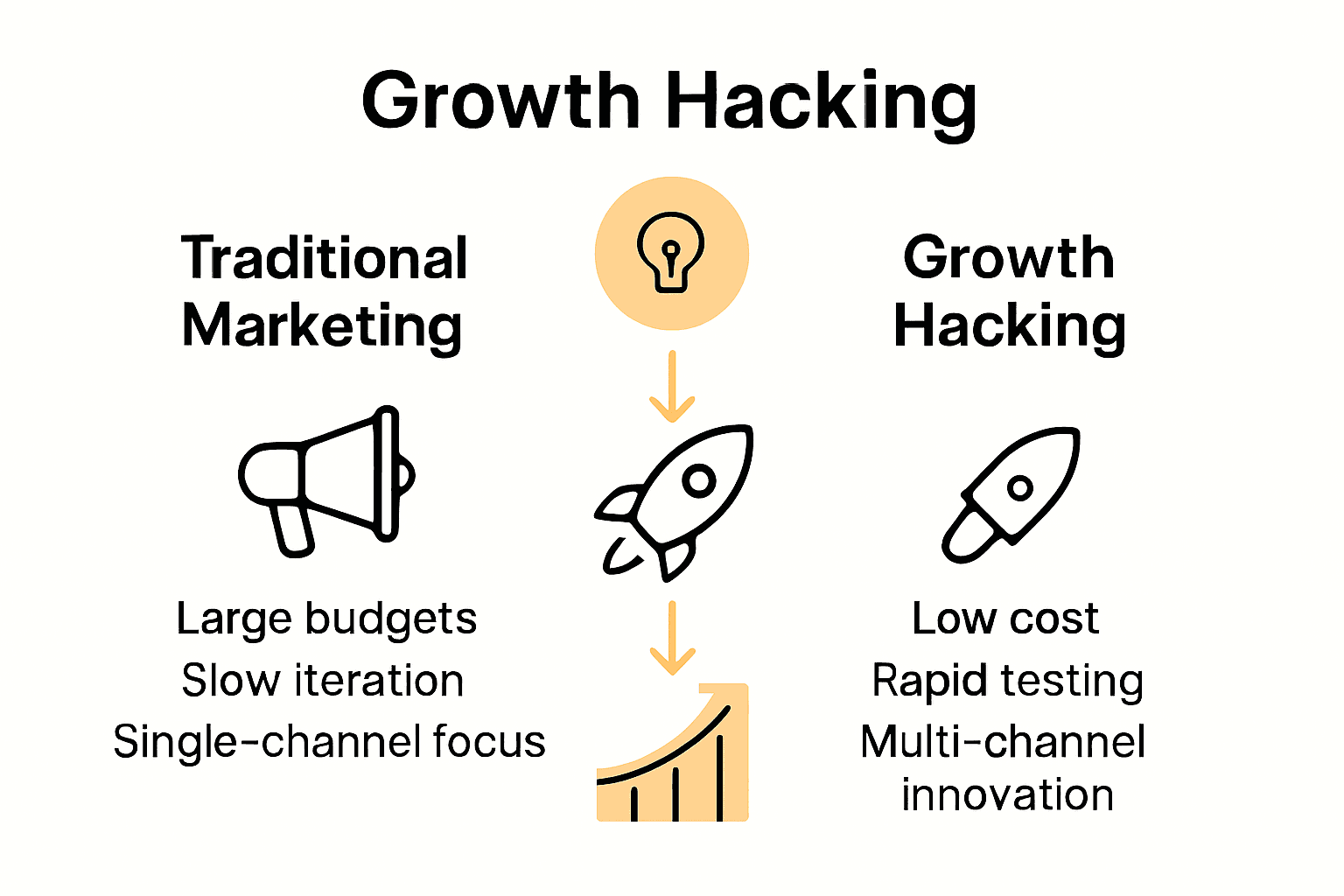What Is Growth Hacking? Complete Guide for Brands
Did you know that companies using growth hacking tactics can see user numbers double or even triple in a matter of months? With digital competition at an all-time high, brands need smarter ways to gain loyal customers without blowing the budget. Growth hacking combines rapid testing, creative collaboration, and data-driven methods to unlock real results fast. This guide shows how top brands turn unconventional strategies into explosive growth, helping you make every marketing effort count.
Key Takeaways
| Point | Details |
|---|---|
| Growth Hacking Methodology | It combines marketing and innovative experimentation for rapid user acquisition and retention. |
| Core Principles | Focus on rapid experimentation, low-cost techniques, and data-driven decisions to optimize growth. |
| Ecommerce Strategies | Employ techniques like conversion optimization and personalized marketing to enhance user engagement and sales. |
| Avoiding Pitfalls | Prioritize sustained long-term growth over short-term gains to maintain user trust and brand integrity. |
Table of Contents
- Growth Hacking Defined And Core Principles
- Key Strategies And Tactics In Growth Hacking
- Types Of Growth Hacking For Ecommerce Brands
- Real-World Growth Hacking Use Cases
- Risks, Limitations, And Common Mistakes
Growth Hacking Defined and Core Principles
Growth hacking isn’t just another marketing buzzword—it’s a strategic approach that transforms how brands acquire, engage, and retain customers. Growth hacking represents a laser-focused methodology where traditional marketing meets innovative, data-driven experimentation. According to Wikipedia, it’s a specialized subfield dedicated to rapidly accelerating company growth through continuous testing and optimization.

At its core, growth hacking combines multiple disciplines into a powerful growth strategy. The key characteristics include:
Here’s a summary of core growth hacking principles:
| Principle | Description | Key Benefit |
|---|---|---|
| Rapid Experimentation | Testing multiple ideas quickly | Faster learning cycles |
| Low-Cost Techniques | Smart marketing without big budgets | Efficient resource use |
| Cross-functional Collaboration | Marketers, developers, and product teams | Broader skill application |
| Data-driven Decision Making | Using analytics and user metrics | Informed strategic choices |
- Rapid experimentation: Constantly testing different approaches to discover what drives user acquisition
- Low-cost techniques: Leveraging innovative marketing methods that don’t require massive budgets
- Cross-functional collaboration: Integrating marketers, developers, engineers, and product managers
- Data-driven decision making: Using analytics and metrics to guide strategic choices
The most successful growth hackers think beyond traditional marketing channels. They focus on scalable, repeatable strategies that can dramatically expand a brand’s user base. Take Action’s guide on scaling digital marketing explores how these techniques can transform your business approach. Whether it’s viral marketing, strategic SEO, website optimization, or creative social media campaigns, growth hacking is about finding unconventional paths to accelerate user acquisition and retention.
Understand this: Growth hacking isn’t a one-size-fits-all solution. It’s a mindset of continuous learning, experimenting, and adapting. Brands that master this approach can achieve exponential growth without massive marketing expenditures, turning limited resources into significant competitive advantages.
Key Strategies and Tactics in Growth Hacking
Growth hacking demands creative, strategic approaches that go far beyond traditional marketing playbooks. Innovative engagement tactics are the secret weapon for brands looking to accelerate user acquisition and retention. According to insights from SuiteJar, modern growth strategies leverage cutting-edge techniques like interactive content, voice search optimization, and hyper-targeted marketing to break through the digital noise.
Successful growth hackers employ a diverse toolkit of strategic tactics:
- Interactive Content: Creating immersive experiences like quizzes, augmented reality (AR) interactions, and engaging multimedia that capture user attention
- Voice Search Optimization: Developing conversational keywords and local SEO strategies to improve discoverability
- Personalized Marketing: Using advanced data analytics to deliver precisely targeted email campaigns and user experiences
- Viral Mechanism Design: Implementing referral programs and shareable content that naturally expand user reach
Take Action’s personalized email campaigns guide demonstrates how precise targeting can transform marketing effectiveness. The key is understanding that growth hacking isn’t about massive budgets—it’s about smart, data-driven experiments that create exponential user engagement.
The most powerful growth hacking strategies view every interaction as an opportunity for optimization. By continuously testing, measuring, and refining approaches, brands can unlock unprecedented growth potential without enormous marketing expenditures.
 Success comes from being agile, creative, and relentlessly focused on delivering genuine value to your target audience.
Success comes from being agile, creative, and relentlessly focused on delivering genuine value to your target audience.
Types of Growth Hacking for Ecommerce Brands
Ecommerce growth hacking isn’t a one-size-fits-all approach—it’s a dynamic strategy tailored to your brand’s unique ecosystem. Different types of growth hacking techniques can be deployed strategically to unlock exponential user acquisition, engagement, and revenue generation. These techniques focus on innovative methods that transcend traditional marketing limitations.
Key types of growth hacking for ecommerce brands include:
- Conversion Rate Optimization (CRO): Systematically improving website elements to increase purchase likelihood
- Viral Referral Mechanisms: Designing incentive structures that motivate customers to share and recommend products
- Retention Hacking: Creating personalized post-purchase experiences that encourage repeat buying
- Social Proof Amplification: Leveraging user reviews, testimonials, and social media engagement to build trust
- Abandoned Cart Recovery: Implementing strategic email and retargeting campaigns to recapture potential lost sales
Our comprehensive ecommerce marketing strategies guide provides deeper insights into these techniques. Successful growth hackers understand that each strategy must be meticulously tested, measured, and refined to deliver meaningful results.
Ultimately, growth hacking for ecommerce is about creating intelligent, adaptive systems that turn casual browsers into loyal customers. By combining data-driven insights, creative problem-solving, and continuous experimentation, brands can develop growth mechanisms that scale efficiently and consistently. The most effective growth hackers view every interaction as an opportunity for optimization and value creation.
Real-World Growth Hacking Use Cases
Growth hacking transforms theoretical strategies into powerful, actionable results across diverse industries. Real-world case studies demonstrate how innovative brands leverage unconventional techniques to achieve remarkable growth, proving that creative problem-solving can dramatically accelerate business expansion.
Some compelling growth hacking use cases include:
- Dropbox’s Referral Program: Offering free storage space for each successful user referral, which drove user acquisition from 100,000 to 4 million in just 15 months
- Airbnb’s Craigslist Integration: Developing a clever hack to cross-post listings on Craigslist, exponentially expanding their market reach
- Spotify’s Social Sharing: Implementing seamless social media integration that allowed users to share music directly, driving viral user growth
- Instagram’s Exclusivity Strategy: Initially launching only on iOS and creating artificial scarcity that drove massive platform curiosity
- Uber’s Referral Mechanism: Creating a two-sided referral program where both the referrer and referred user received ride credits
Our guide on increasing online sales explores similar innovative tactics that brands can implement. These examples illustrate that growth hacking isn’t about massive budgets, but about intelligent, creative strategies that create exponential user engagement.
Successful growth hacking requires a combination of technical creativity, deep user understanding, and relentless experimentation. Brands that master this approach can transform limited resources into significant competitive advantages, turning innovative ideas into scalable, repeatable growth mechanisms that redefine traditional marketing boundaries.
Risks, Limitations, and Common Mistakes
Growth hacking isn’t a magical solution—it’s a strategic approach with potential pitfalls that can derail even the most innovative marketing efforts. While the allure of rapid expansion is tempting, brands must navigate carefully to avoid common traps that can compromise long-term sustainability and user trust.
Common growth hacking mistakes and risks include:
- Over-optimization Syndrome: Focusing so intensely on metrics that you lose sight of genuine user experience
- Short-term Thinking: Implementing tactics that drive immediate gains but damage long-term brand reputation
- Data Misinterpretation: Drawing incorrect conclusions from analytics by not understanding contextual nuances
- Ethical Boundary Crossing: Pushing growth strategies that compromise user privacy or create negative user sentiment
- Lack of Consistent Testing: Failing to continuously iterate and refine growth strategies
According to Omniconvert’s research, even minor user experience elements can significantly impact conversion rates. In one case study, simply improving popup navigation, visibility, and adding an ‘Add to Cart’ button increased conversion rates by nearly 6% and revenue per user by almost 5%. Our guide on increasing online sales provides deeper insights into avoiding these common pitfalls.
Successful growth hackers understand that sustainable growth requires a delicate balance between aggressive experimentation and maintaining user trust. The most effective strategies prioritize long-term value creation over short-term gains, continuously learning and adapting to evolving user needs and market dynamics.
Ready to Turn Growth Hacking Insights Into Real Revenue Gains?
If this guide on growth hacking sparked ideas for your brand but you are struggling to put these strategies into action, we understand how overwhelming it can feel. The pressure to run rapid experiments, implement innovative retention tactics, and make data-driven marketing decisions can hold you back from the real results you want: more loyal customers and higher revenue.

Let Take Action help you unlock the full potential of your email channel. We specialize in automated, conversion-focused email marketing that brings growth hacking strategies to life. Whether you want to recover abandoned carts, perfect your personalized campaigns, or scale retention using Klaviyo, our team blends expert strategy with AI-powered insights to drive results you can measure. Visit our website now and transform your email into a reliable growth engine. Your next leap in engagement and revenue can start today.
Frequently Asked Questions
What is growth hacking?
Growth hacking is a strategic approach that combines marketing and innovation focused on rapid experimentation and data-driven techniques to accelerate user acquisition and retention.
What are the key principles of growth hacking?
The core principles of growth hacking include rapid experimentation, low-cost techniques, cross-functional collaboration, and data-driven decision making for optimizing growth strategies.
How can ecommerce brands implement growth hacking strategies?
Ecommerce brands can implement growth hacking through techniques like conversion rate optimization, viral referral mechanisms, retention hacking, social proof amplification, and abandoned cart recovery strategies.
What are some common mistakes to avoid in growth hacking?
Common mistakes in growth hacking include over-optimization, short-term thinking, misinterpretation of data, crossing ethical boundaries, and failing to conduct consistent testing.
Recommended
- Blog - Email Marketing Insights | Take Action | Take Action
- Understanding UGC in Marketing: A Deep Dive | Take Action Blog | Take Action
- Scaling Digital Marketing: Strategies for 2025 Success | Take Action Blog | Take Action
- 7 Evergreen Content Ideas for Growing Your Brand | Take Action Blog | Take Action
- Top Strategies for Website Growth in 2025: Boost Traffic & Results
